University Marketing Report: Social Media's Impact on Business
VerifiedAdded on 2022/08/25
|20
|4223
|37
Report
AI Summary
This report explores the significant impact of social media on modern marketing strategies. It begins by establishing the rationale for the study, highlighting the evolution of marketing from traditional methods, such as print and visual media, to the digital age. The report identifies the issues associated with traditional marketing, including high costs and limited reach, and contrasts them with the benefits of social media marketing, such as increased customer engagement and cost-effectiveness. The literature review delves into the concept of social media, its applications, and its influence on business operations. The research methodology section outlines the deductive approach and research design employed, covering data collection strategies, sampling techniques, and ethical considerations. The report aims to identify the issues in traditional marketing, investigate the influence of social media on marketing, and recommend strategies for improving the efficiency of social media in marketing. The report concludes by emphasizing the positive impact of social media on marketing, including its role in brand awareness, customer engagement, and overall business growth.
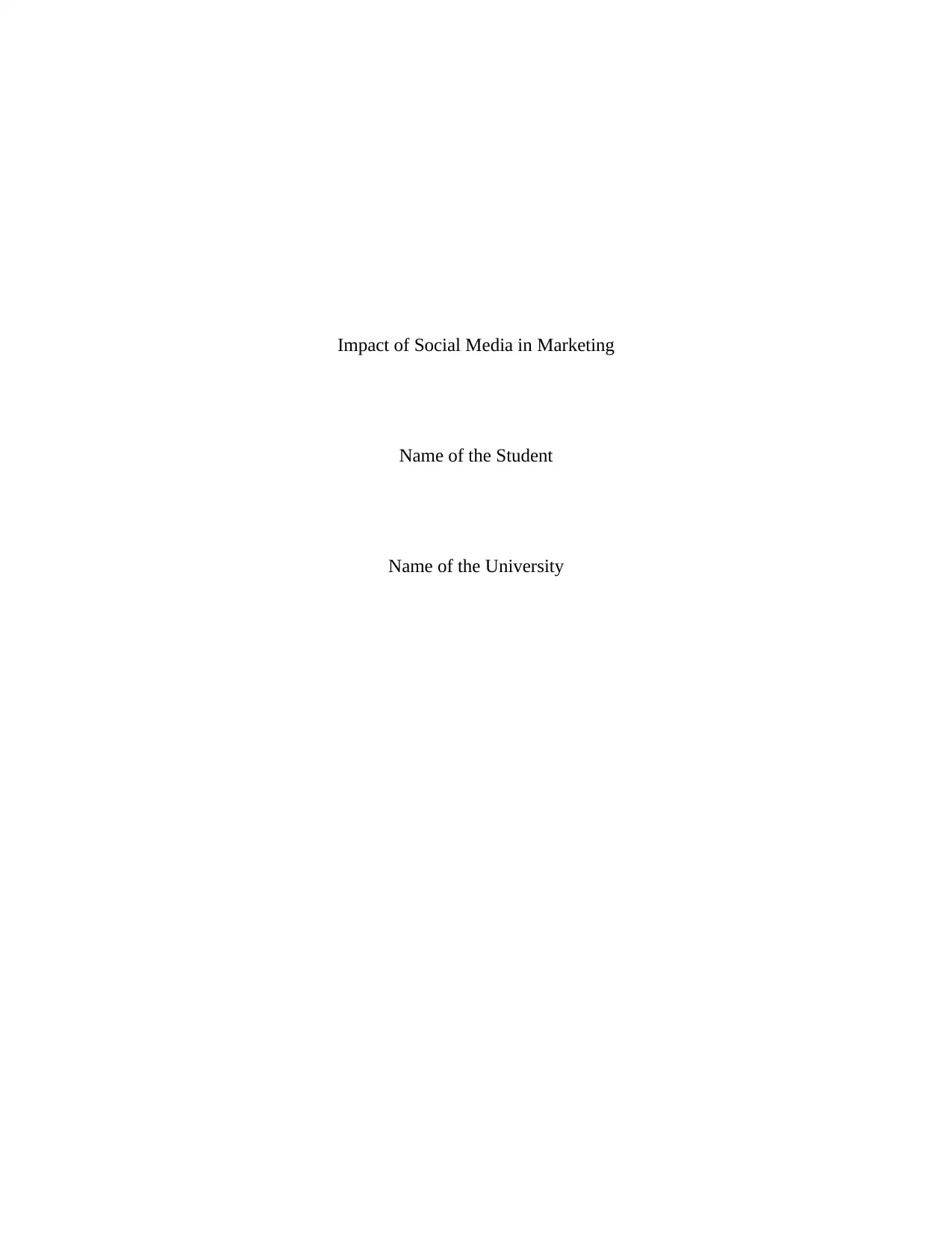
Impact of Social Media in Marketing
Name of the Student
Name of the University
Name of the Student
Name of the University
Paraphrase This Document
Need a fresh take? Get an instant paraphrase of this document with our AI Paraphraser
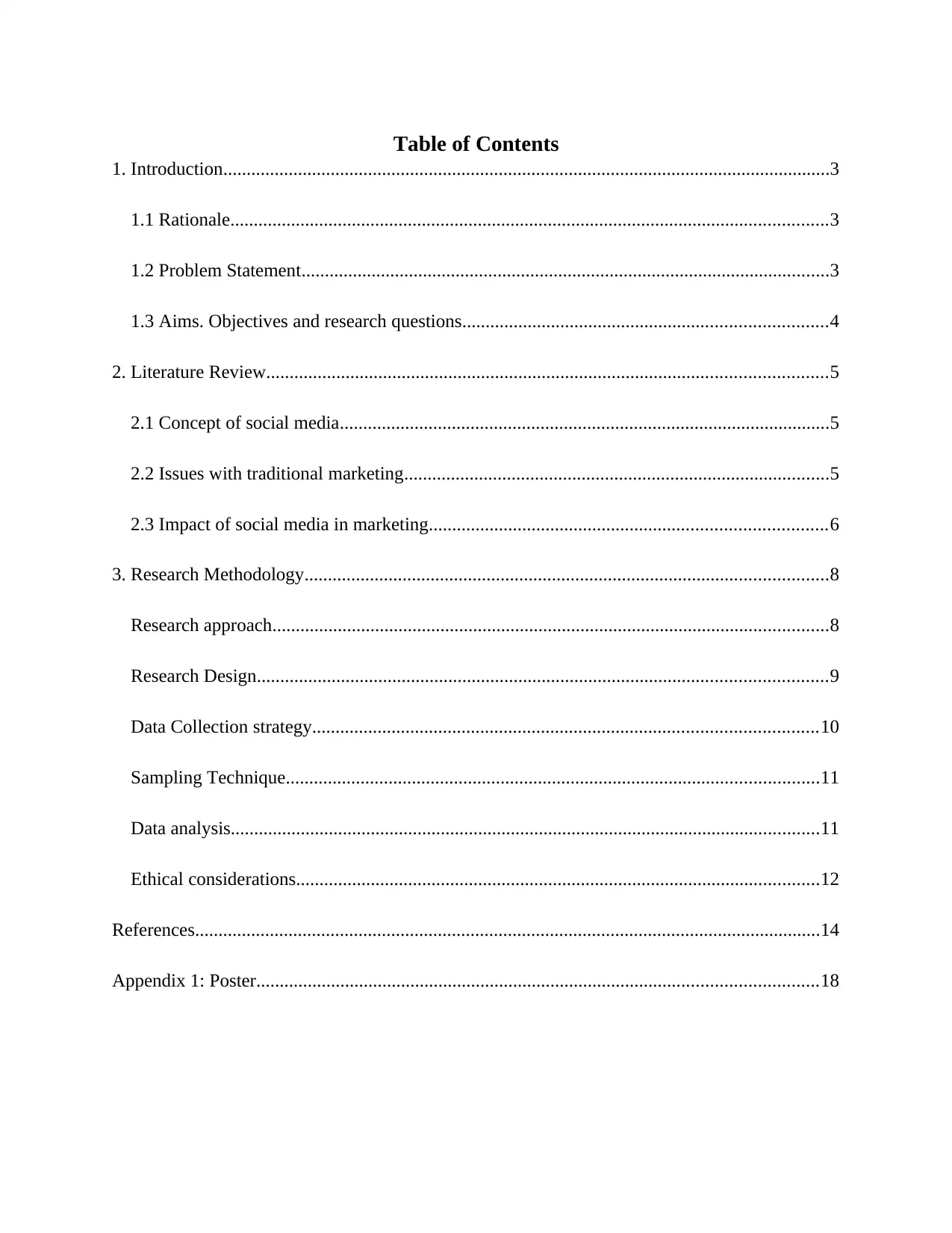
Table of Contents
1. Introduction..................................................................................................................................3
1.1 Rationale................................................................................................................................3
1.2 Problem Statement.................................................................................................................3
1.3 Aims. Objectives and research questions..............................................................................4
2. Literature Review........................................................................................................................5
2.1 Concept of social media.........................................................................................................5
2.2 Issues with traditional marketing...........................................................................................5
2.3 Impact of social media in marketing.....................................................................................6
3. Research Methodology................................................................................................................8
Research approach.......................................................................................................................8
Research Design..........................................................................................................................9
Data Collection strategy............................................................................................................10
Sampling Technique..................................................................................................................11
Data analysis..............................................................................................................................11
Ethical considerations................................................................................................................12
References......................................................................................................................................14
Appendix 1: Poster........................................................................................................................18
1. Introduction..................................................................................................................................3
1.1 Rationale................................................................................................................................3
1.2 Problem Statement.................................................................................................................3
1.3 Aims. Objectives and research questions..............................................................................4
2. Literature Review........................................................................................................................5
2.1 Concept of social media.........................................................................................................5
2.2 Issues with traditional marketing...........................................................................................5
2.3 Impact of social media in marketing.....................................................................................6
3. Research Methodology................................................................................................................8
Research approach.......................................................................................................................8
Research Design..........................................................................................................................9
Data Collection strategy............................................................................................................10
Sampling Technique..................................................................................................................11
Data analysis..............................................................................................................................11
Ethical considerations................................................................................................................12
References......................................................................................................................................14
Appendix 1: Poster........................................................................................................................18
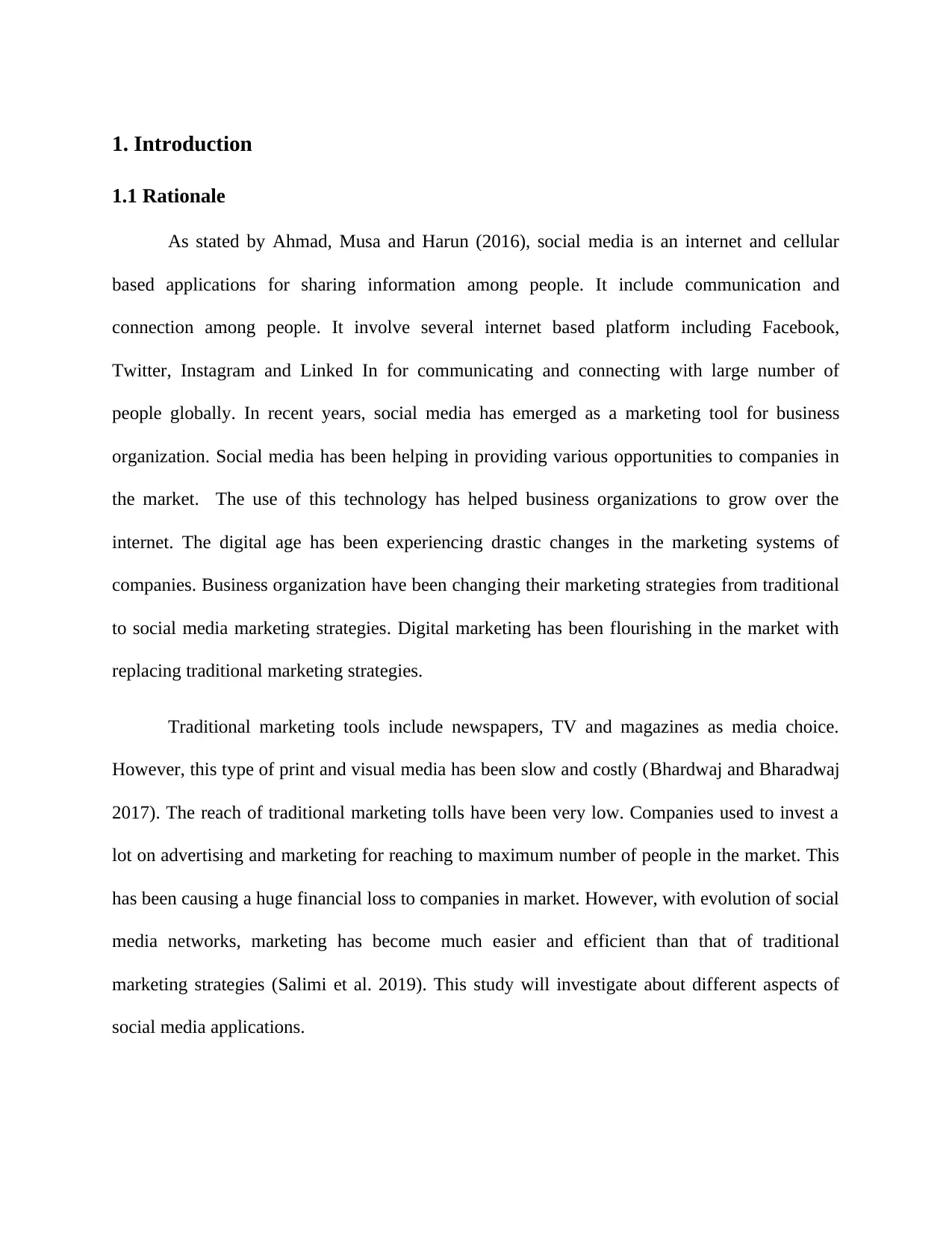
1. Introduction
1.1 Rationale
As stated by Ahmad, Musa and Harun (2016), social media is an internet and cellular
based applications for sharing information among people. It include communication and
connection among people. It involve several internet based platform including Facebook,
Twitter, Instagram and Linked In for communicating and connecting with large number of
people globally. In recent years, social media has emerged as a marketing tool for business
organization. Social media has been helping in providing various opportunities to companies in
the market. The use of this technology has helped business organizations to grow over the
internet. The digital age has been experiencing drastic changes in the marketing systems of
companies. Business organization have been changing their marketing strategies from traditional
to social media marketing strategies. Digital marketing has been flourishing in the market with
replacing traditional marketing strategies.
Traditional marketing tools include newspapers, TV and magazines as media choice.
However, this type of print and visual media has been slow and costly (Bhardwaj and Bharadwaj
2017). The reach of traditional marketing tolls have been very low. Companies used to invest a
lot on advertising and marketing for reaching to maximum number of people in the market. This
has been causing a huge financial loss to companies in market. However, with evolution of social
media networks, marketing has become much easier and efficient than that of traditional
marketing strategies (Salimi et al. 2019). This study will investigate about different aspects of
social media applications.
1.1 Rationale
As stated by Ahmad, Musa and Harun (2016), social media is an internet and cellular
based applications for sharing information among people. It include communication and
connection among people. It involve several internet based platform including Facebook,
Twitter, Instagram and Linked In for communicating and connecting with large number of
people globally. In recent years, social media has emerged as a marketing tool for business
organization. Social media has been helping in providing various opportunities to companies in
the market. The use of this technology has helped business organizations to grow over the
internet. The digital age has been experiencing drastic changes in the marketing systems of
companies. Business organization have been changing their marketing strategies from traditional
to social media marketing strategies. Digital marketing has been flourishing in the market with
replacing traditional marketing strategies.
Traditional marketing tools include newspapers, TV and magazines as media choice.
However, this type of print and visual media has been slow and costly (Bhardwaj and Bharadwaj
2017). The reach of traditional marketing tolls have been very low. Companies used to invest a
lot on advertising and marketing for reaching to maximum number of people in the market. This
has been causing a huge financial loss to companies in market. However, with evolution of social
media networks, marketing has become much easier and efficient than that of traditional
marketing strategies (Salimi et al. 2019). This study will investigate about different aspects of
social media applications.
⊘ This is a preview!⊘
Do you want full access?
Subscribe today to unlock all pages.

Trusted by 1+ million students worldwide
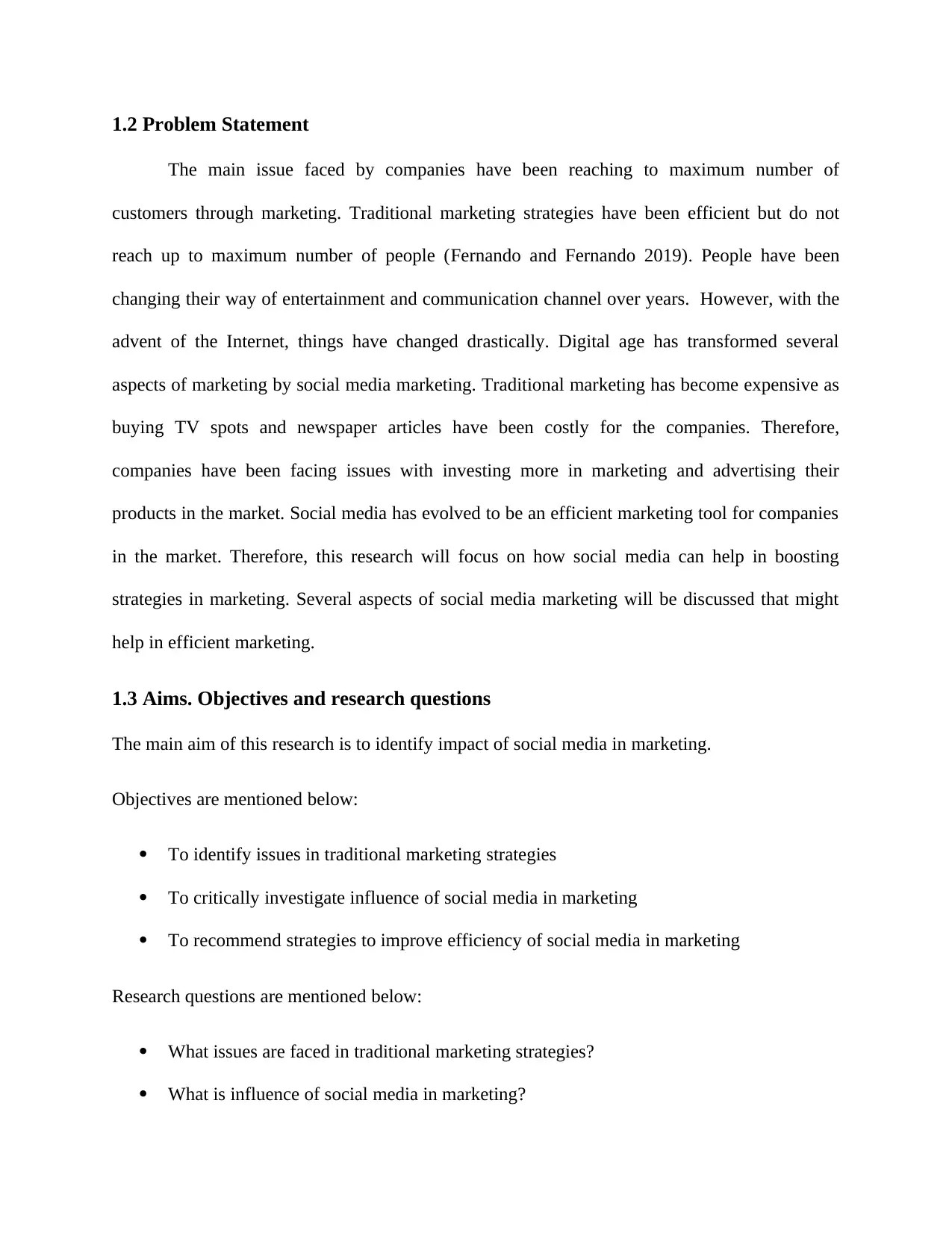
1.2 Problem Statement
The main issue faced by companies have been reaching to maximum number of
customers through marketing. Traditional marketing strategies have been efficient but do not
reach up to maximum number of people (Fernando and Fernando 2019). People have been
changing their way of entertainment and communication channel over years. However, with the
advent of the Internet, things have changed drastically. Digital age has transformed several
aspects of marketing by social media marketing. Traditional marketing has become expensive as
buying TV spots and newspaper articles have been costly for the companies. Therefore,
companies have been facing issues with investing more in marketing and advertising their
products in the market. Social media has evolved to be an efficient marketing tool for companies
in the market. Therefore, this research will focus on how social media can help in boosting
strategies in marketing. Several aspects of social media marketing will be discussed that might
help in efficient marketing.
1.3 Aims. Objectives and research questions
The main aim of this research is to identify impact of social media in marketing.
Objectives are mentioned below:
To identify issues in traditional marketing strategies
To critically investigate influence of social media in marketing
To recommend strategies to improve efficiency of social media in marketing
Research questions are mentioned below:
What issues are faced in traditional marketing strategies?
What is influence of social media in marketing?
The main issue faced by companies have been reaching to maximum number of
customers through marketing. Traditional marketing strategies have been efficient but do not
reach up to maximum number of people (Fernando and Fernando 2019). People have been
changing their way of entertainment and communication channel over years. However, with the
advent of the Internet, things have changed drastically. Digital age has transformed several
aspects of marketing by social media marketing. Traditional marketing has become expensive as
buying TV spots and newspaper articles have been costly for the companies. Therefore,
companies have been facing issues with investing more in marketing and advertising their
products in the market. Social media has evolved to be an efficient marketing tool for companies
in the market. Therefore, this research will focus on how social media can help in boosting
strategies in marketing. Several aspects of social media marketing will be discussed that might
help in efficient marketing.
1.3 Aims. Objectives and research questions
The main aim of this research is to identify impact of social media in marketing.
Objectives are mentioned below:
To identify issues in traditional marketing strategies
To critically investigate influence of social media in marketing
To recommend strategies to improve efficiency of social media in marketing
Research questions are mentioned below:
What issues are faced in traditional marketing strategies?
What is influence of social media in marketing?
Paraphrase This Document
Need a fresh take? Get an instant paraphrase of this document with our AI Paraphraser
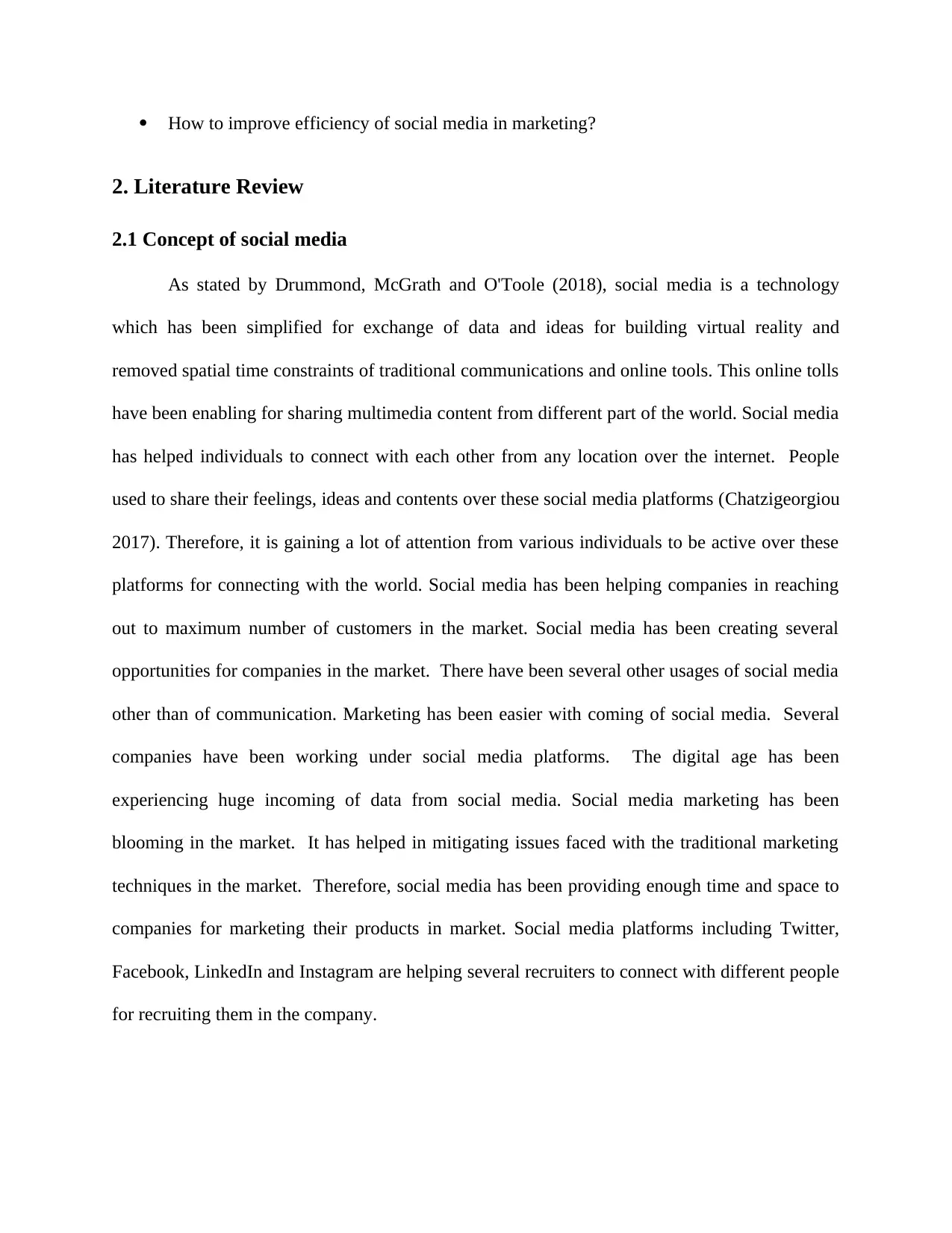
How to improve efficiency of social media in marketing?
2. Literature Review
2.1 Concept of social media
As stated by Drummond, McGrath and O'Toole (2018), social media is a technology
which has been simplified for exchange of data and ideas for building virtual reality and
removed spatial time constraints of traditional communications and online tools. This online tolls
have been enabling for sharing multimedia content from different part of the world. Social media
has helped individuals to connect with each other from any location over the internet. People
used to share their feelings, ideas and contents over these social media platforms (Chatzigeorgiou
2017). Therefore, it is gaining a lot of attention from various individuals to be active over these
platforms for connecting with the world. Social media has been helping companies in reaching
out to maximum number of customers in the market. Social media has been creating several
opportunities for companies in the market. There have been several other usages of social media
other than of communication. Marketing has been easier with coming of social media. Several
companies have been working under social media platforms. The digital age has been
experiencing huge incoming of data from social media. Social media marketing has been
blooming in the market. It has helped in mitigating issues faced with the traditional marketing
techniques in the market. Therefore, social media has been providing enough time and space to
companies for marketing their products in market. Social media platforms including Twitter,
Facebook, LinkedIn and Instagram are helping several recruiters to connect with different people
for recruiting them in the company.
2. Literature Review
2.1 Concept of social media
As stated by Drummond, McGrath and O'Toole (2018), social media is a technology
which has been simplified for exchange of data and ideas for building virtual reality and
removed spatial time constraints of traditional communications and online tools. This online tolls
have been enabling for sharing multimedia content from different part of the world. Social media
has helped individuals to connect with each other from any location over the internet. People
used to share their feelings, ideas and contents over these social media platforms (Chatzigeorgiou
2017). Therefore, it is gaining a lot of attention from various individuals to be active over these
platforms for connecting with the world. Social media has been helping companies in reaching
out to maximum number of customers in the market. Social media has been creating several
opportunities for companies in the market. There have been several other usages of social media
other than of communication. Marketing has been easier with coming of social media. Several
companies have been working under social media platforms. The digital age has been
experiencing huge incoming of data from social media. Social media marketing has been
blooming in the market. It has helped in mitigating issues faced with the traditional marketing
techniques in the market. Therefore, social media has been providing enough time and space to
companies for marketing their products in market. Social media platforms including Twitter,
Facebook, LinkedIn and Instagram are helping several recruiters to connect with different people
for recruiting them in the company.
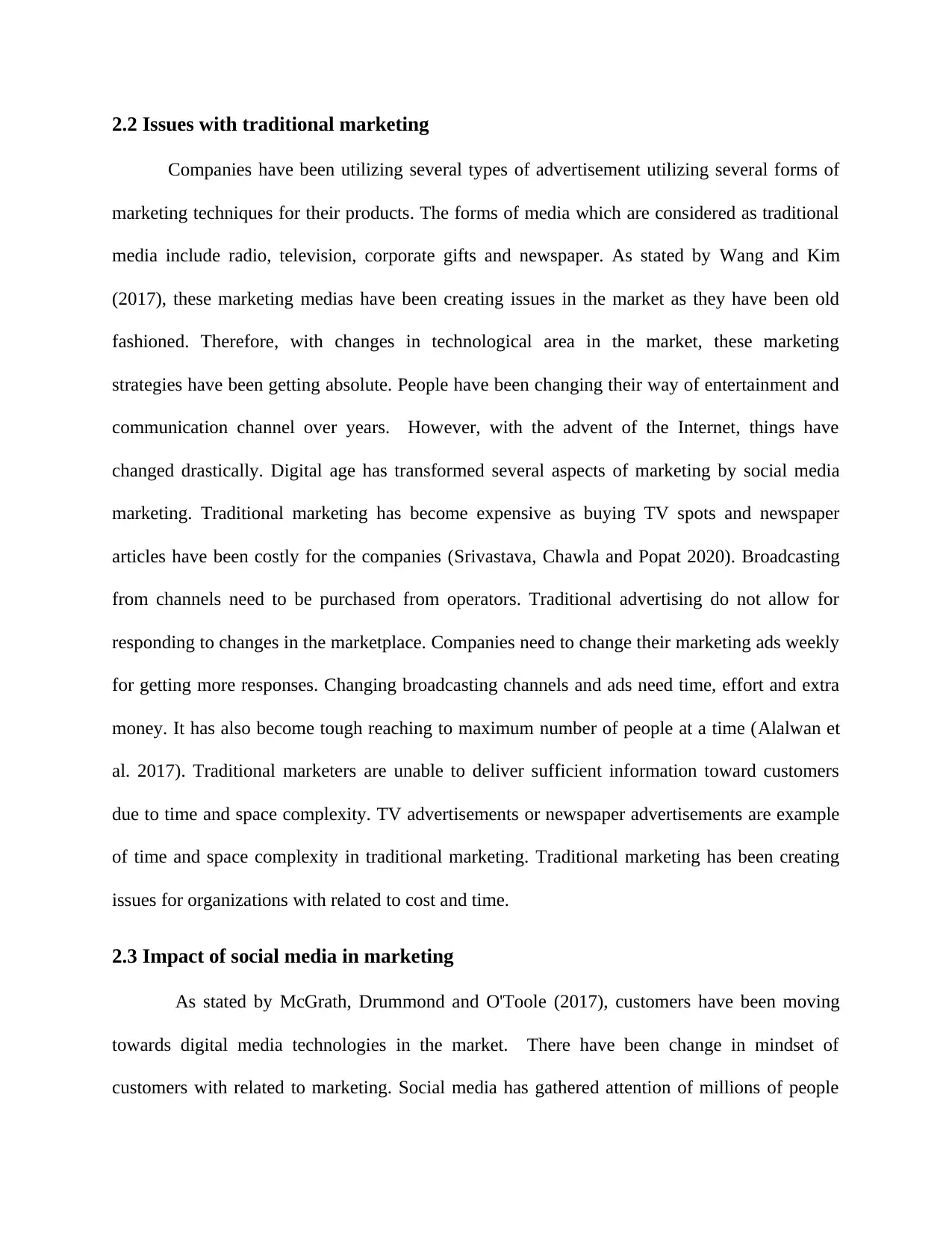
2.2 Issues with traditional marketing
Companies have been utilizing several types of advertisement utilizing several forms of
marketing techniques for their products. The forms of media which are considered as traditional
media include radio, television, corporate gifts and newspaper. As stated by Wang and Kim
(2017), these marketing medias have been creating issues in the market as they have been old
fashioned. Therefore, with changes in technological area in the market, these marketing
strategies have been getting absolute. People have been changing their way of entertainment and
communication channel over years. However, with the advent of the Internet, things have
changed drastically. Digital age has transformed several aspects of marketing by social media
marketing. Traditional marketing has become expensive as buying TV spots and newspaper
articles have been costly for the companies (Srivastava, Chawla and Popat 2020). Broadcasting
from channels need to be purchased from operators. Traditional advertising do not allow for
responding to changes in the marketplace. Companies need to change their marketing ads weekly
for getting more responses. Changing broadcasting channels and ads need time, effort and extra
money. It has also become tough reaching to maximum number of people at a time (Alalwan et
al. 2017). Traditional marketers are unable to deliver sufficient information toward customers
due to time and space complexity. TV advertisements or newspaper advertisements are example
of time and space complexity in traditional marketing. Traditional marketing has been creating
issues for organizations with related to cost and time.
2.3 Impact of social media in marketing
As stated by McGrath, Drummond and O'Toole (2017), customers have been moving
towards digital media technologies in the market. There have been change in mindset of
customers with related to marketing. Social media has gathered attention of millions of people
Companies have been utilizing several types of advertisement utilizing several forms of
marketing techniques for their products. The forms of media which are considered as traditional
media include radio, television, corporate gifts and newspaper. As stated by Wang and Kim
(2017), these marketing medias have been creating issues in the market as they have been old
fashioned. Therefore, with changes in technological area in the market, these marketing
strategies have been getting absolute. People have been changing their way of entertainment and
communication channel over years. However, with the advent of the Internet, things have
changed drastically. Digital age has transformed several aspects of marketing by social media
marketing. Traditional marketing has become expensive as buying TV spots and newspaper
articles have been costly for the companies (Srivastava, Chawla and Popat 2020). Broadcasting
from channels need to be purchased from operators. Traditional advertising do not allow for
responding to changes in the marketplace. Companies need to change their marketing ads weekly
for getting more responses. Changing broadcasting channels and ads need time, effort and extra
money. It has also become tough reaching to maximum number of people at a time (Alalwan et
al. 2017). Traditional marketers are unable to deliver sufficient information toward customers
due to time and space complexity. TV advertisements or newspaper advertisements are example
of time and space complexity in traditional marketing. Traditional marketing has been creating
issues for organizations with related to cost and time.
2.3 Impact of social media in marketing
As stated by McGrath, Drummond and O'Toole (2017), customers have been moving
towards digital media technologies in the market. There have been change in mindset of
customers with related to marketing. Social media has gathered attention of millions of people
⊘ This is a preview!⊘
Do you want full access?
Subscribe today to unlock all pages.

Trusted by 1+ million students worldwide
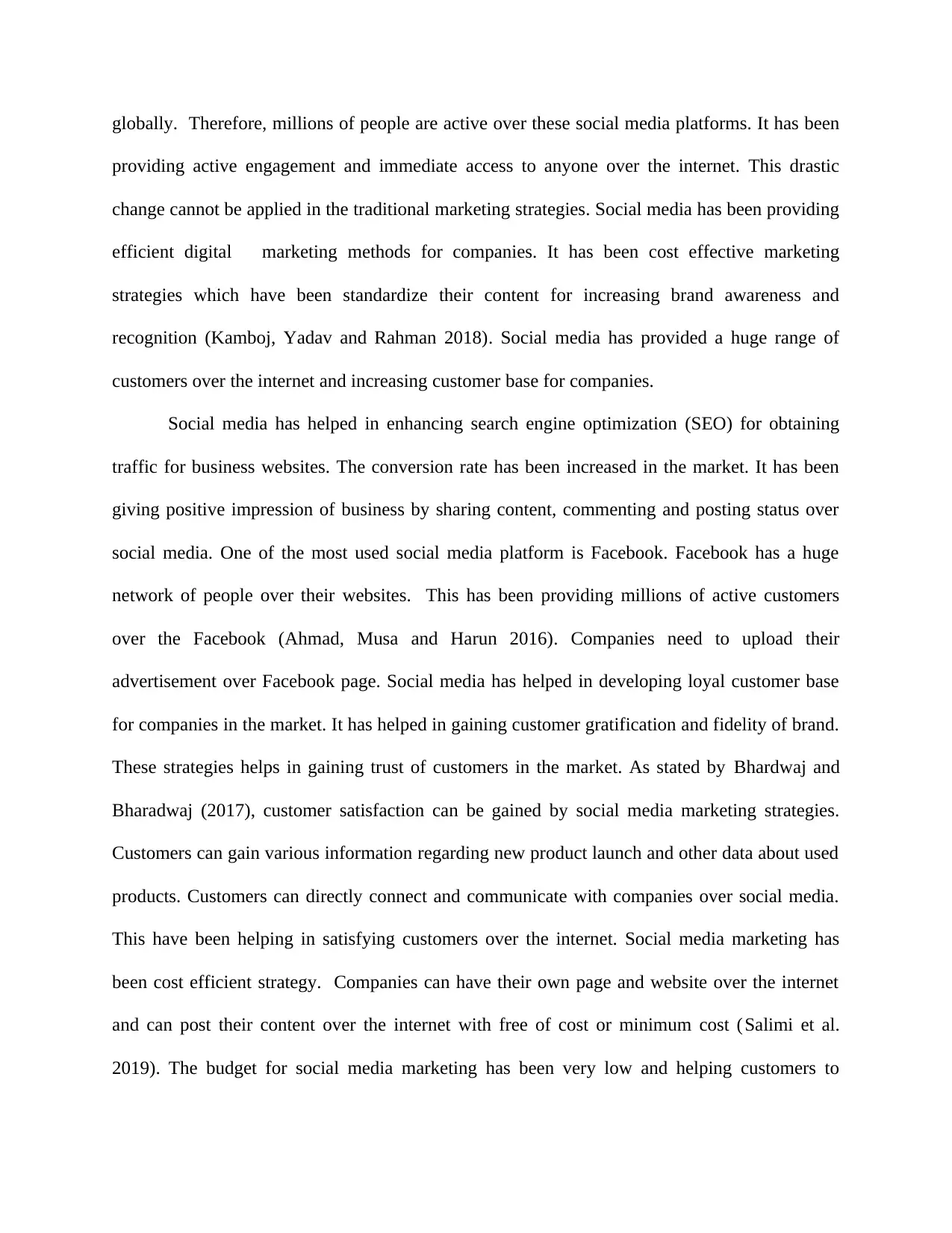
globally. Therefore, millions of people are active over these social media platforms. It has been
providing active engagement and immediate access to anyone over the internet. This drastic
change cannot be applied in the traditional marketing strategies. Social media has been providing
efficient digital marketing methods for companies. It has been cost effective marketing
strategies which have been standardize their content for increasing brand awareness and
recognition (Kamboj, Yadav and Rahman 2018). Social media has provided a huge range of
customers over the internet and increasing customer base for companies.
Social media has helped in enhancing search engine optimization (SEO) for obtaining
traffic for business websites. The conversion rate has been increased in the market. It has been
giving positive impression of business by sharing content, commenting and posting status over
social media. One of the most used social media platform is Facebook. Facebook has a huge
network of people over their websites. This has been providing millions of active customers
over the Facebook (Ahmad, Musa and Harun 2016). Companies need to upload their
advertisement over Facebook page. Social media has helped in developing loyal customer base
for companies in the market. It has helped in gaining customer gratification and fidelity of brand.
These strategies helps in gaining trust of customers in the market. As stated by Bhardwaj and
Bharadwaj (2017), customer satisfaction can be gained by social media marketing strategies.
Customers can gain various information regarding new product launch and other data about used
products. Customers can directly connect and communicate with companies over social media.
This have been helping in satisfying customers over the internet. Social media marketing has
been cost efficient strategy. Companies can have their own page and website over the internet
and can post their content over the internet with free of cost or minimum cost (Salimi et al.
2019). The budget for social media marketing has been very low and helping customers to
providing active engagement and immediate access to anyone over the internet. This drastic
change cannot be applied in the traditional marketing strategies. Social media has been providing
efficient digital marketing methods for companies. It has been cost effective marketing
strategies which have been standardize their content for increasing brand awareness and
recognition (Kamboj, Yadav and Rahman 2018). Social media has provided a huge range of
customers over the internet and increasing customer base for companies.
Social media has helped in enhancing search engine optimization (SEO) for obtaining
traffic for business websites. The conversion rate has been increased in the market. It has been
giving positive impression of business by sharing content, commenting and posting status over
social media. One of the most used social media platform is Facebook. Facebook has a huge
network of people over their websites. This has been providing millions of active customers
over the Facebook (Ahmad, Musa and Harun 2016). Companies need to upload their
advertisement over Facebook page. Social media has helped in developing loyal customer base
for companies in the market. It has helped in gaining customer gratification and fidelity of brand.
These strategies helps in gaining trust of customers in the market. As stated by Bhardwaj and
Bharadwaj (2017), customer satisfaction can be gained by social media marketing strategies.
Customers can gain various information regarding new product launch and other data about used
products. Customers can directly connect and communicate with companies over social media.
This have been helping in satisfying customers over the internet. Social media marketing has
been cost efficient strategy. Companies can have their own page and website over the internet
and can post their content over the internet with free of cost or minimum cost (Salimi et al.
2019). The budget for social media marketing has been very low and helping customers to
Paraphrase This Document
Need a fresh take? Get an instant paraphrase of this document with our AI Paraphraser
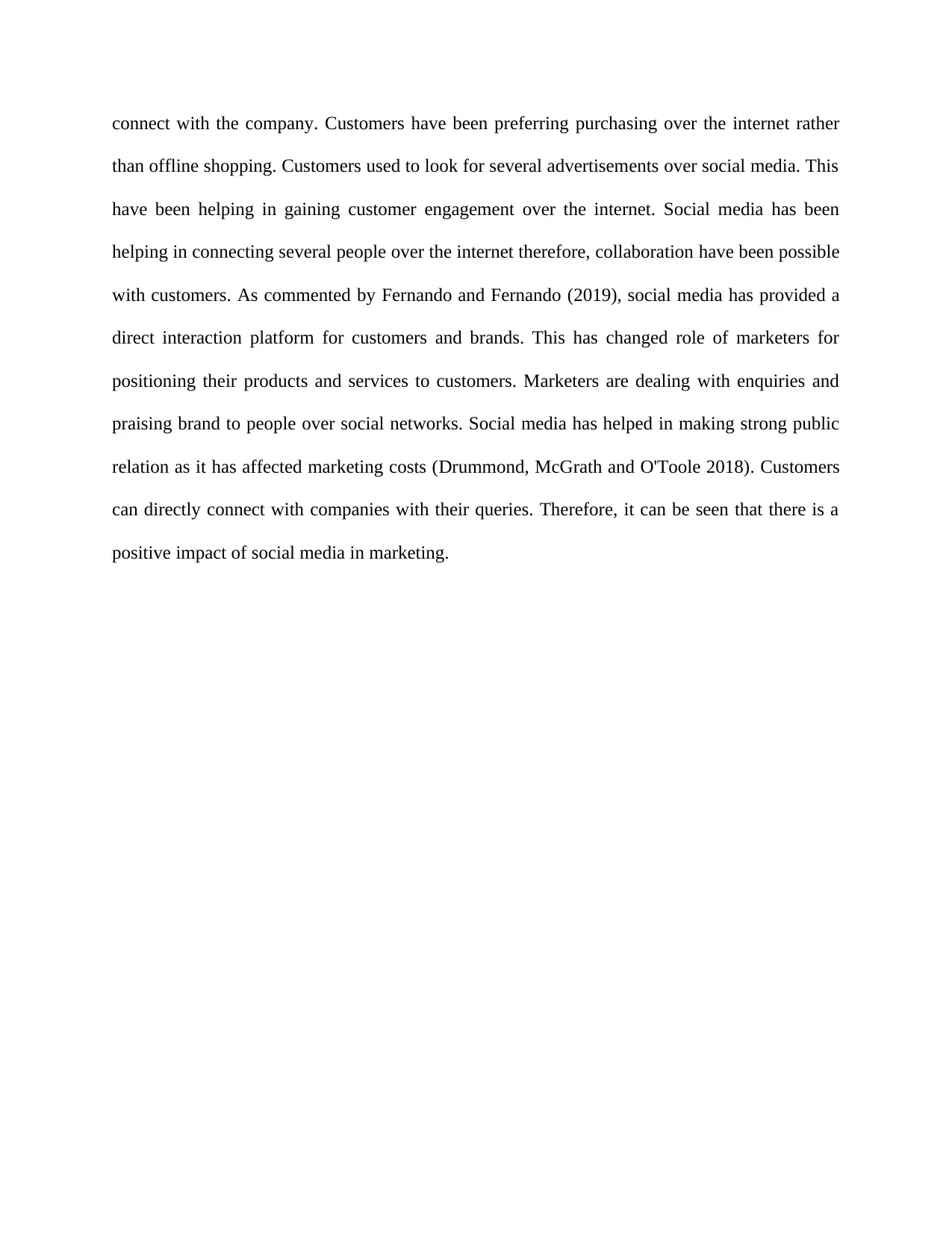
connect with the company. Customers have been preferring purchasing over the internet rather
than offline shopping. Customers used to look for several advertisements over social media. This
have been helping in gaining customer engagement over the internet. Social media has been
helping in connecting several people over the internet therefore, collaboration have been possible
with customers. As commented by Fernando and Fernando (2019), social media has provided a
direct interaction platform for customers and brands. This has changed role of marketers for
positioning their products and services to customers. Marketers are dealing with enquiries and
praising brand to people over social networks. Social media has helped in making strong public
relation as it has affected marketing costs (Drummond, McGrath and O'Toole 2018). Customers
can directly connect with companies with their queries. Therefore, it can be seen that there is a
positive impact of social media in marketing.
than offline shopping. Customers used to look for several advertisements over social media. This
have been helping in gaining customer engagement over the internet. Social media has been
helping in connecting several people over the internet therefore, collaboration have been possible
with customers. As commented by Fernando and Fernando (2019), social media has provided a
direct interaction platform for customers and brands. This has changed role of marketers for
positioning their products and services to customers. Marketers are dealing with enquiries and
praising brand to people over social networks. Social media has helped in making strong public
relation as it has affected marketing costs (Drummond, McGrath and O'Toole 2018). Customers
can directly connect with companies with their queries. Therefore, it can be seen that there is a
positive impact of social media in marketing.
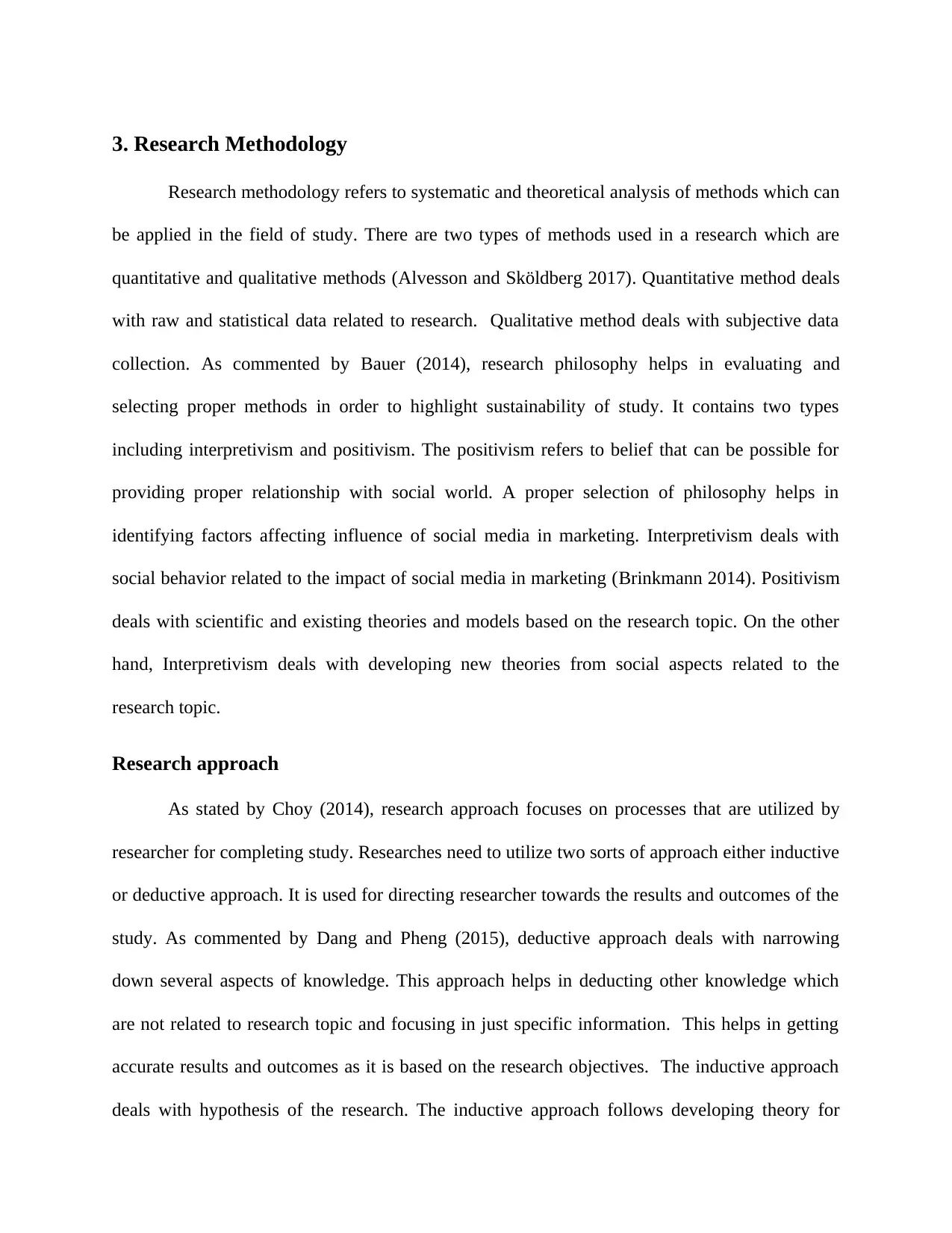
3. Research Methodology
Research methodology refers to systematic and theoretical analysis of methods which can
be applied in the field of study. There are two types of methods used in a research which are
quantitative and qualitative methods (Alvesson and Sköldberg 2017). Quantitative method deals
with raw and statistical data related to research. Qualitative method deals with subjective data
collection. As commented by Bauer (2014), research philosophy helps in evaluating and
selecting proper methods in order to highlight sustainability of study. It contains two types
including interpretivism and positivism. The positivism refers to belief that can be possible for
providing proper relationship with social world. A proper selection of philosophy helps in
identifying factors affecting influence of social media in marketing. Interpretivism deals with
social behavior related to the impact of social media in marketing (Brinkmann 2014). Positivism
deals with scientific and existing theories and models based on the research topic. On the other
hand, Interpretivism deals with developing new theories from social aspects related to the
research topic.
Research approach
As stated by Choy (2014), research approach focuses on processes that are utilized by
researcher for completing study. Researches need to utilize two sorts of approach either inductive
or deductive approach. It is used for directing researcher towards the results and outcomes of the
study. As commented by Dang and Pheng (2015), deductive approach deals with narrowing
down several aspects of knowledge. This approach helps in deducting other knowledge which
are not related to research topic and focusing in just specific information. This helps in getting
accurate results and outcomes as it is based on the research objectives. The inductive approach
deals with hypothesis of the research. The inductive approach follows developing theory for
Research methodology refers to systematic and theoretical analysis of methods which can
be applied in the field of study. There are two types of methods used in a research which are
quantitative and qualitative methods (Alvesson and Sköldberg 2017). Quantitative method deals
with raw and statistical data related to research. Qualitative method deals with subjective data
collection. As commented by Bauer (2014), research philosophy helps in evaluating and
selecting proper methods in order to highlight sustainability of study. It contains two types
including interpretivism and positivism. The positivism refers to belief that can be possible for
providing proper relationship with social world. A proper selection of philosophy helps in
identifying factors affecting influence of social media in marketing. Interpretivism deals with
social behavior related to the impact of social media in marketing (Brinkmann 2014). Positivism
deals with scientific and existing theories and models based on the research topic. On the other
hand, Interpretivism deals with developing new theories from social aspects related to the
research topic.
Research approach
As stated by Choy (2014), research approach focuses on processes that are utilized by
researcher for completing study. Researches need to utilize two sorts of approach either inductive
or deductive approach. It is used for directing researcher towards the results and outcomes of the
study. As commented by Dang and Pheng (2015), deductive approach deals with narrowing
down several aspects of knowledge. This approach helps in deducting other knowledge which
are not related to research topic and focusing in just specific information. This helps in getting
accurate results and outcomes as it is based on the research objectives. The inductive approach
deals with hypothesis of the research. The inductive approach follows developing theory for
⊘ This is a preview!⊘
Do you want full access?
Subscribe today to unlock all pages.

Trusted by 1+ million students worldwide
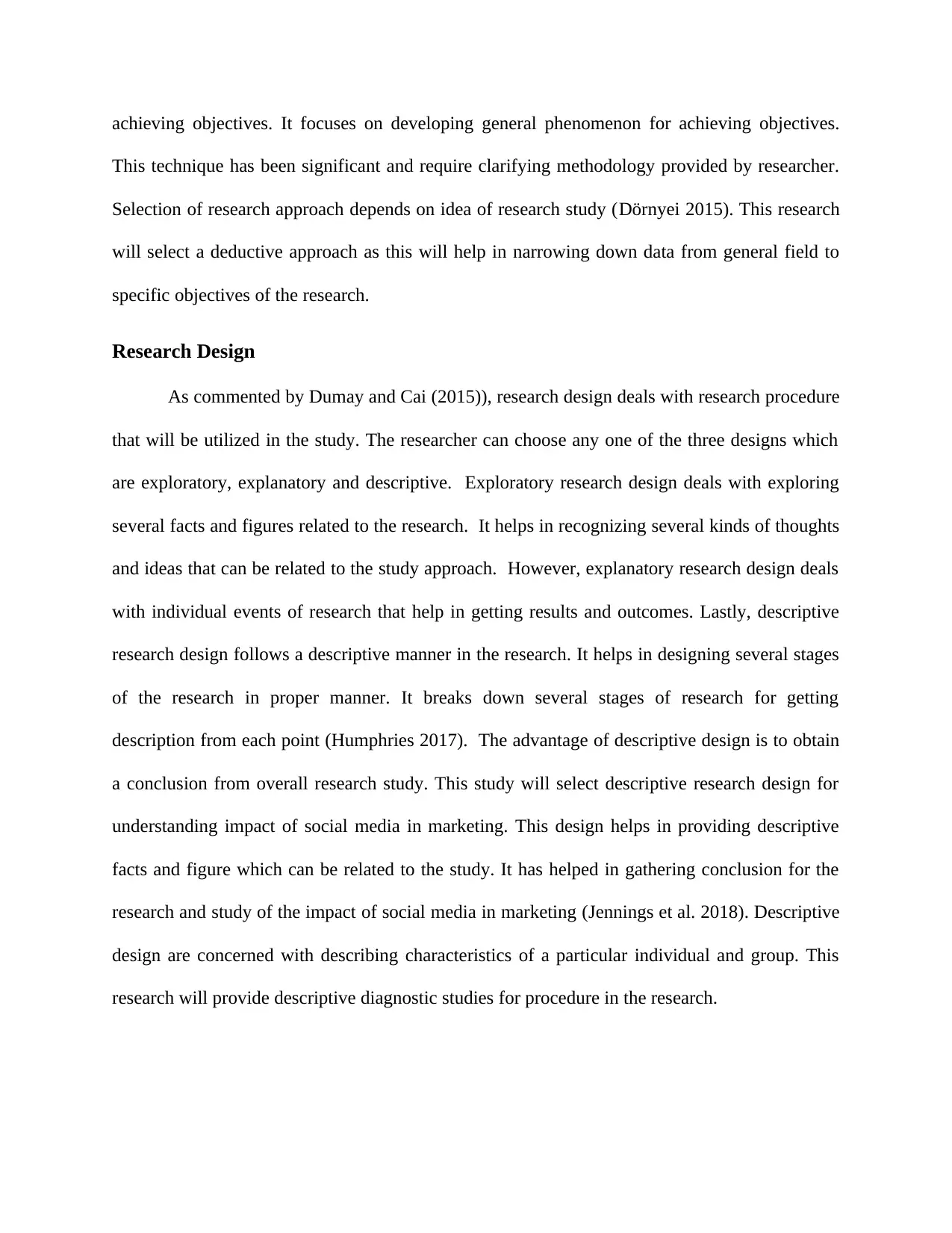
achieving objectives. It focuses on developing general phenomenon for achieving objectives.
This technique has been significant and require clarifying methodology provided by researcher.
Selection of research approach depends on idea of research study (Dörnyei 2015). This research
will select a deductive approach as this will help in narrowing down data from general field to
specific objectives of the research.
Research Design
As commented by Dumay and Cai (2015)), research design deals with research procedure
that will be utilized in the study. The researcher can choose any one of the three designs which
are exploratory, explanatory and descriptive. Exploratory research design deals with exploring
several facts and figures related to the research. It helps in recognizing several kinds of thoughts
and ideas that can be related to the study approach. However, explanatory research design deals
with individual events of research that help in getting results and outcomes. Lastly, descriptive
research design follows a descriptive manner in the research. It helps in designing several stages
of the research in proper manner. It breaks down several stages of research for getting
description from each point (Humphries 2017). The advantage of descriptive design is to obtain
a conclusion from overall research study. This study will select descriptive research design for
understanding impact of social media in marketing. This design helps in providing descriptive
facts and figure which can be related to the study. It has helped in gathering conclusion for the
research and study of the impact of social media in marketing (Jennings et al. 2018). Descriptive
design are concerned with describing characteristics of a particular individual and group. This
research will provide descriptive diagnostic studies for procedure in the research.
This technique has been significant and require clarifying methodology provided by researcher.
Selection of research approach depends on idea of research study (Dörnyei 2015). This research
will select a deductive approach as this will help in narrowing down data from general field to
specific objectives of the research.
Research Design
As commented by Dumay and Cai (2015)), research design deals with research procedure
that will be utilized in the study. The researcher can choose any one of the three designs which
are exploratory, explanatory and descriptive. Exploratory research design deals with exploring
several facts and figures related to the research. It helps in recognizing several kinds of thoughts
and ideas that can be related to the study approach. However, explanatory research design deals
with individual events of research that help in getting results and outcomes. Lastly, descriptive
research design follows a descriptive manner in the research. It helps in designing several stages
of the research in proper manner. It breaks down several stages of research for getting
description from each point (Humphries 2017). The advantage of descriptive design is to obtain
a conclusion from overall research study. This study will select descriptive research design for
understanding impact of social media in marketing. This design helps in providing descriptive
facts and figure which can be related to the study. It has helped in gathering conclusion for the
research and study of the impact of social media in marketing (Jennings et al. 2018). Descriptive
design are concerned with describing characteristics of a particular individual and group. This
research will provide descriptive diagnostic studies for procedure in the research.
Paraphrase This Document
Need a fresh take? Get an instant paraphrase of this document with our AI Paraphraser
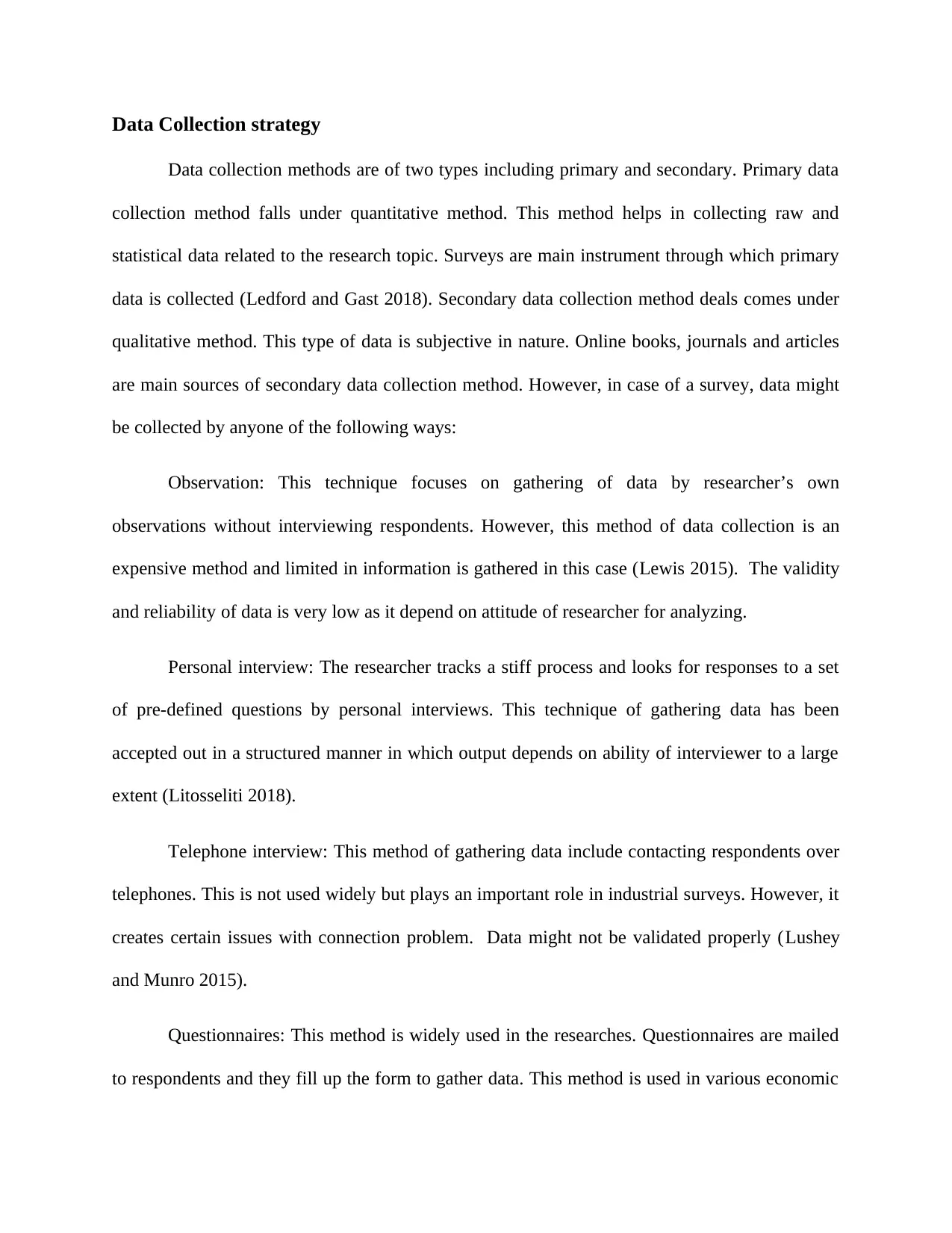
Data Collection strategy
Data collection methods are of two types including primary and secondary. Primary data
collection method falls under quantitative method. This method helps in collecting raw and
statistical data related to the research topic. Surveys are main instrument through which primary
data is collected (Ledford and Gast 2018). Secondary data collection method deals comes under
qualitative method. This type of data is subjective in nature. Online books, journals and articles
are main sources of secondary data collection method. However, in case of a survey, data might
be collected by anyone of the following ways:
Observation: This technique focuses on gathering of data by researcher’s own
observations without interviewing respondents. However, this method of data collection is an
expensive method and limited in information is gathered in this case (Lewis 2015). The validity
and reliability of data is very low as it depend on attitude of researcher for analyzing.
Personal interview: The researcher tracks a stiff process and looks for responses to a set
of pre-defined questions by personal interviews. This technique of gathering data has been
accepted out in a structured manner in which output depends on ability of interviewer to a large
extent (Litosseliti 2018).
Telephone interview: This method of gathering data include contacting respondents over
telephones. This is not used widely but plays an important role in industrial surveys. However, it
creates certain issues with connection problem. Data might not be validated properly (Lushey
and Munro 2015).
Questionnaires: This method is widely used in the researches. Questionnaires are mailed
to respondents and they fill up the form to gather data. This method is used in various economic
Data collection methods are of two types including primary and secondary. Primary data
collection method falls under quantitative method. This method helps in collecting raw and
statistical data related to the research topic. Surveys are main instrument through which primary
data is collected (Ledford and Gast 2018). Secondary data collection method deals comes under
qualitative method. This type of data is subjective in nature. Online books, journals and articles
are main sources of secondary data collection method. However, in case of a survey, data might
be collected by anyone of the following ways:
Observation: This technique focuses on gathering of data by researcher’s own
observations without interviewing respondents. However, this method of data collection is an
expensive method and limited in information is gathered in this case (Lewis 2015). The validity
and reliability of data is very low as it depend on attitude of researcher for analyzing.
Personal interview: The researcher tracks a stiff process and looks for responses to a set
of pre-defined questions by personal interviews. This technique of gathering data has been
accepted out in a structured manner in which output depends on ability of interviewer to a large
extent (Litosseliti 2018).
Telephone interview: This method of gathering data include contacting respondents over
telephones. This is not used widely but plays an important role in industrial surveys. However, it
creates certain issues with connection problem. Data might not be validated properly (Lushey
and Munro 2015).
Questionnaires: This method is widely used in the researches. Questionnaires are mailed
to respondents and they fill up the form to gather data. This method is used in various economic
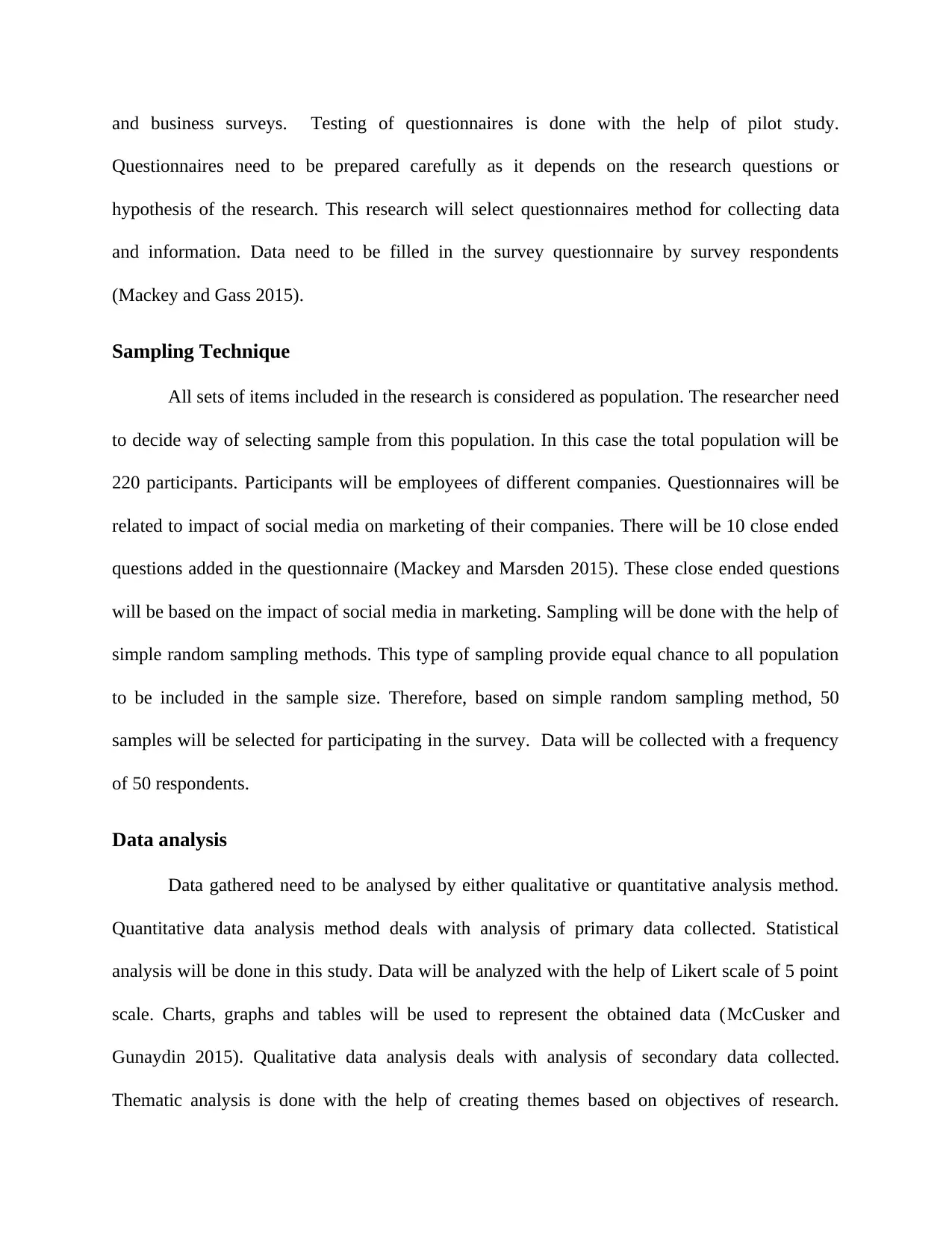
and business surveys. Testing of questionnaires is done with the help of pilot study.
Questionnaires need to be prepared carefully as it depends on the research questions or
hypothesis of the research. This research will select questionnaires method for collecting data
and information. Data need to be filled in the survey questionnaire by survey respondents
(Mackey and Gass 2015).
Sampling Technique
All sets of items included in the research is considered as population. The researcher need
to decide way of selecting sample from this population. In this case the total population will be
220 participants. Participants will be employees of different companies. Questionnaires will be
related to impact of social media on marketing of their companies. There will be 10 close ended
questions added in the questionnaire (Mackey and Marsden 2015). These close ended questions
will be based on the impact of social media in marketing. Sampling will be done with the help of
simple random sampling methods. This type of sampling provide equal chance to all population
to be included in the sample size. Therefore, based on simple random sampling method, 50
samples will be selected for participating in the survey. Data will be collected with a frequency
of 50 respondents.
Data analysis
Data gathered need to be analysed by either qualitative or quantitative analysis method.
Quantitative data analysis method deals with analysis of primary data collected. Statistical
analysis will be done in this study. Data will be analyzed with the help of Likert scale of 5 point
scale. Charts, graphs and tables will be used to represent the obtained data (McCusker and
Gunaydin 2015). Qualitative data analysis deals with analysis of secondary data collected.
Thematic analysis is done with the help of creating themes based on objectives of research.
Questionnaires need to be prepared carefully as it depends on the research questions or
hypothesis of the research. This research will select questionnaires method for collecting data
and information. Data need to be filled in the survey questionnaire by survey respondents
(Mackey and Gass 2015).
Sampling Technique
All sets of items included in the research is considered as population. The researcher need
to decide way of selecting sample from this population. In this case the total population will be
220 participants. Participants will be employees of different companies. Questionnaires will be
related to impact of social media on marketing of their companies. There will be 10 close ended
questions added in the questionnaire (Mackey and Marsden 2015). These close ended questions
will be based on the impact of social media in marketing. Sampling will be done with the help of
simple random sampling methods. This type of sampling provide equal chance to all population
to be included in the sample size. Therefore, based on simple random sampling method, 50
samples will be selected for participating in the survey. Data will be collected with a frequency
of 50 respondents.
Data analysis
Data gathered need to be analysed by either qualitative or quantitative analysis method.
Quantitative data analysis method deals with analysis of primary data collected. Statistical
analysis will be done in this study. Data will be analyzed with the help of Likert scale of 5 point
scale. Charts, graphs and tables will be used to represent the obtained data (McCusker and
Gunaydin 2015). Qualitative data analysis deals with analysis of secondary data collected.
Thematic analysis is done with the help of creating themes based on objectives of research.
⊘ This is a preview!⊘
Do you want full access?
Subscribe today to unlock all pages.

Trusted by 1+ million students worldwide
1 out of 20
Related Documents
Your All-in-One AI-Powered Toolkit for Academic Success.
+13062052269
info@desklib.com
Available 24*7 on WhatsApp / Email
![[object Object]](/_next/static/media/star-bottom.7253800d.svg)
Unlock your academic potential
Copyright © 2020–2025 A2Z Services. All Rights Reserved. Developed and managed by ZUCOL.





